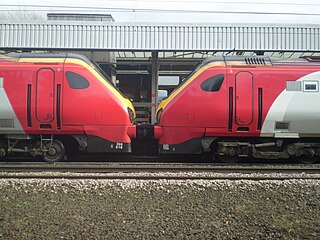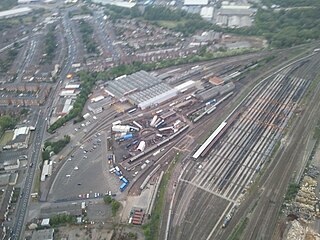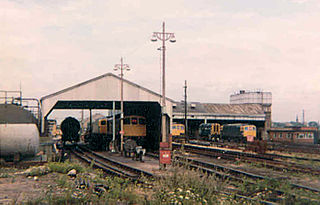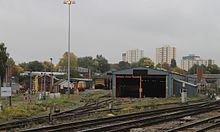
First Greater Western, trading as Great Western Railway (GWR), is a British train operating company owned by FirstGroup that provides services in the Greater Western franchise area. It manages 197 stations and its trains call at over 270. GWR operates long-distance inter-city services along the Great Western Main Line to and from the West of England and South Wales, inter-city services from London to the West Country via the Reading–Taunton line, and the Night Riviera sleeper service between London and Penzance. It provides outer-suburban services in West London; commuter services from its London terminus at London Paddington to the Thames Valley region, including parts of Berkshire and Buckinghamshire, and Oxfordshire; and regional services throughout the West of England and South Wales to the South coast of England. Great Western Railway also operates the Heathrow Express service.

The British Rail Class 89 is a prototype electric locomotive. Only one was built, in 1986, by British Rail Engineering Limited's Crewe Works. It was used on test-trains on both the West Coast and East Coast Main Lines. The locomotive was fitted with advanced power control systems and developed more than 6,000 bhp. After being withdrawn in 1992, it was returned to service in 1996, before being again withdrawn in 2000. As of January 2021, it is in the final stages of an overhaul that will return it to the main line.

The British Rail Class 170 Turbostar is a British diesel-hydraulic multiple unit passenger train designed and built by Adtranz, and later by Bombardier Transportation, at Derby Litchurch Lane Works.

The British Rail Class 153 Super Sprinter are single-coach diesel-hydraulic railcars which were converted from two-coach Class 155 diesel multiple units in the early 1990s. The class was intended for service on rural branch lines, either where passenger numbers do not justify longer trains or to boost the capacity on services with high passenger volume.

The British Rail Class 180 is a class of 14 diesel-hydraulic multiple unit passenger trains manufactured by Alstom at its Washwood Heath factory in 2000–01 for First Great Western (FGW). They are part of the Coradia 1000 family, along with the Class 175.

Virgin CrossCountry was a train operating company in the United Kingdom that operated the InterCity CrossCountry passenger franchise from January 1997 until November 2007. Along with the InterCity West Coast franchise held by a separate legal entity, the company traded under the Virgin Trains brand.

The British Rail Class 220 Voyager is a class of diesel-electric high-speed multiple unit passenger trains built in Belgium by Bombardier Transportation in 2000 and 2001. They were introduced in 2001 to replace the 20-year-old InterCity 125 and almost 40-year-old Class 47-hauled Mark 2 fleets operating on the Cross Country Route. They were initially operated by Virgin CrossCountry and since 2007 have been operated by CrossCountry.

The British Rail Class 221 Super Voyager is a class of tilting diesel-electric multiple unit express passenger trains built in Bruges, Belgium and Wakefield, by Bombardier Transportation in 2001–02.

The British Rail Class 43 (HST) is the TOPS classification used for the InterCity 125 High Speed Train diesel-electric power cars, built by British Rail Engineering Limited from 1975 to 1982, and in service in the UK since 1976.

The Bombardier Voyager is a family of high-speed 125 mph diesel-electric multiple units built in Belgium by Bombardier Transportation, for service on the railway network of the United Kingdom. Construction of the Voyager family took place between 2000 and 2005, consisting of three classes - the Class 220 Voyager, the Class 221 Super Voyager and the Class 222 Meridian.

Allerton TMD is a railway depot situated in Allerton, Liverpool. Situated opposite Liverpool South Parkway bus and rail interchange, it is visible from trains which are travelling between the former and Hunts Cross and the overhead passageway above platforms 1 to 4 at Liverpool South Parkway. The depot is located less than 2 km (1.2 mi) from the Freightliner intermodal terminal at Garston Docks and is also 7 km (4.3 mi) from the Stobart Rail intermodal depot in Widnes.

Longsight Electric TMD is an AC electric railway locomotive traction maintenance depot situated in Longsight, Manchester, England. It is one of the largest train depots in the United Kingdom and can hold 179 carriages at any one time.

Tyseley TMD is a railway traction maintenance depot situated in Tyseley, Birmingham, England.

Neville Hill is a railway train maintenance depot in Osmondthorpe, Leeds, England on the Leeds to Selby Line. The depot is situated 2 miles 14 chains (3.5 km) to the east of Leeds railway station on the north side of the line.

Penzance TMD, also known as Long Rock TMD, is a railway traction maintenance depot situated in the village of Long Rock east of Penzance, Cornwall, England, and is the most westerly and southerly rail depot in the country. The depot operator is Great Western Railway. The depot code is PZ.

Hither Green (London) Traction Maintenance Depot or Hither Green (London) TMD is a railway depot used for the maintenance and servicing of freight trains adjacent to the Hither Green marshalling yard. The depot is a hub for moving freight around southeast England. Hither Green TMD is owned and operated by DBS. The official depot code is HG. In steam days the shed code was 73C.

CrossCountry is a British train operating company owned by Arriva UK Trains, operating the current CrossCountry franchise.
Arriva TrainCare is a railway rolling stock maintenance company. It is presently a wholly-owned subsidiary of Arriva UK Trains.

Holbeck TMD is a traction maintenance depot located in Holbeck, Leeds, England. The depot is located on the west side of the line from Woodlesford, and is 57 chains (1.1 km) south of Leeds railway station.
Eastleigh Depot is a depot location in Eastleigh, Hampshire, England. The depot is situated on the South West Main Line and is near Eastleigh station. The depot code is EH.




















